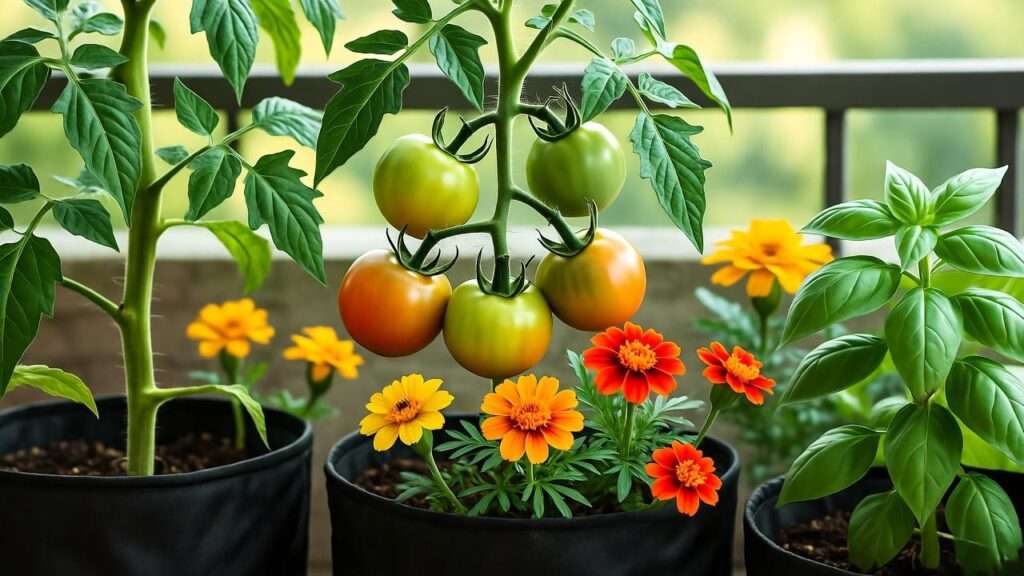Picture this: you step onto your cozy balcony, pluck a ripe, sun-warmed tomato from your patio tomato plants, and savor its burst of flavor—all grown in a tiny space! Whether you’re an urban gardener or a plant enthusiast with just a corner of outdoor space, growing lush patio tomato plants is not only possible but incredibly rewarding. This guide, crafted by a horticultural expert with over a decade of experience in urban gardening, shares five proven tips to help you cultivate thriving tomatoes in containers. From choosing the perfect variety to mastering pest control, you’ll learn everything needed for a bountiful harvest, even in the smallest spaces. Ready to transform your patio into a tomato paradise? Let’s dive in! 🌿
1. Choosing the Right Patio Tomato Varieties 🌿
Selecting the right tomato variety is the foundation of a successful patio garden. Not all tomatoes thrive in confined spaces, so picking compact, high-yielding varieties is key to maximizing your harvest.
Why Variety Matters
Tomato plants come in two main growth habits: determinate (bushy, compact) and indeterminate (vining, sprawling). For patio tomato plants, determinate varieties are often ideal because they stay smaller and produce fruit in a shorter period, perfect for container gardening. Indeterminate varieties can work but require more support and space. Choosing varieties labeled “patio” or “container” ensures they’re bred for small spaces, offering robust yields without overwhelming your balcony or terrace.
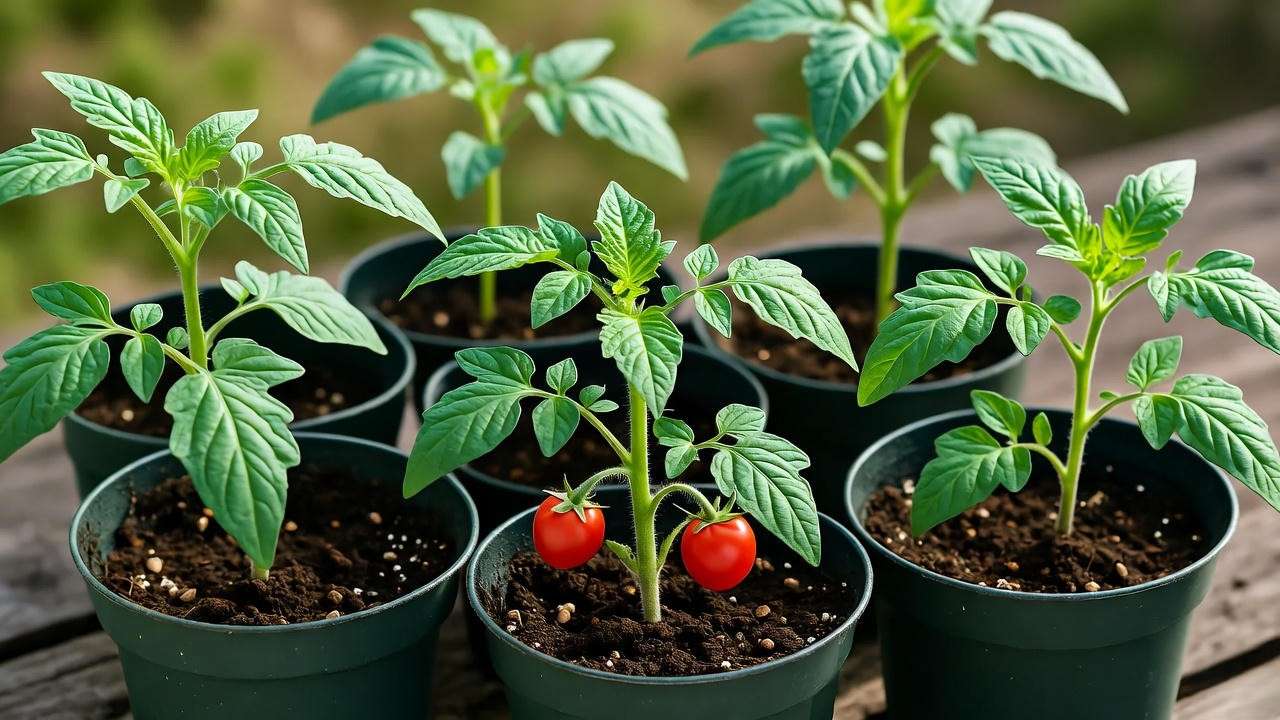
Top Patio-Friendly Tomato Varieties
Here are some of the best varieties for patio gardening:
- Cherry Tomatoes: These small, sweet tomatoes are prolific and perfect for containers. Try Tiny Tim (grows to 12–18 inches), Patio Princess (compact and heavy-yielding), or Sweet 100 (clusters of tiny, flavorful fruits).
- Dwarf Varieties: Red Robin and Micro Tom are ultra-compact, growing to just 6–12 inches, making them ideal for small pots or hanging baskets.
- Heirloom Options: For richer flavor, consider Bush Early Girl or Celebrity, which balance compact growth with delicious fruit.
Expert Tip: Check seed packets or plant tags for “container” or “patio” labels to ensure success. For beginners, cherry tomatoes like Tiny Tim are forgiving and fast-growing. 🌱
Example: Sarah, an apartment dweller in Chicago, grew Tiny Tim in a 5-gallon pot on her balcony. By midsummer, she harvested over 50 cherry tomatoes from a single plant, proving small spaces can yield big results!
2. Selecting the Perfect Containers and Soil 🪴
The right container and soil mix are critical for healthy patio tomato plants. Containers affect root growth, water retention, and plant stability, while soil provides essential nutrients.
Container Size and Material
- Size: Choose a pot that matches your tomato variety. Cherry and dwarf tomatoes need at least a 5-gallon container, while larger determinate varieties like Bush Early Girl require 10–15 gallons. Bigger pots retain moisture better and give roots room to grow.
- Material: Plastic pots are lightweight and retain water well, ideal for hot climates. Terracotta is breathable but dries out faster. Fabric grow bags promote aeration and prevent root circling but need frequent watering.
- Drainage: Ensure pots have drainage holes to prevent root rot, a common issue in container gardening.
Pro Tip: Line the bottom of your pot with a coffee filter to keep soil from escaping while allowing water to drain. ☕
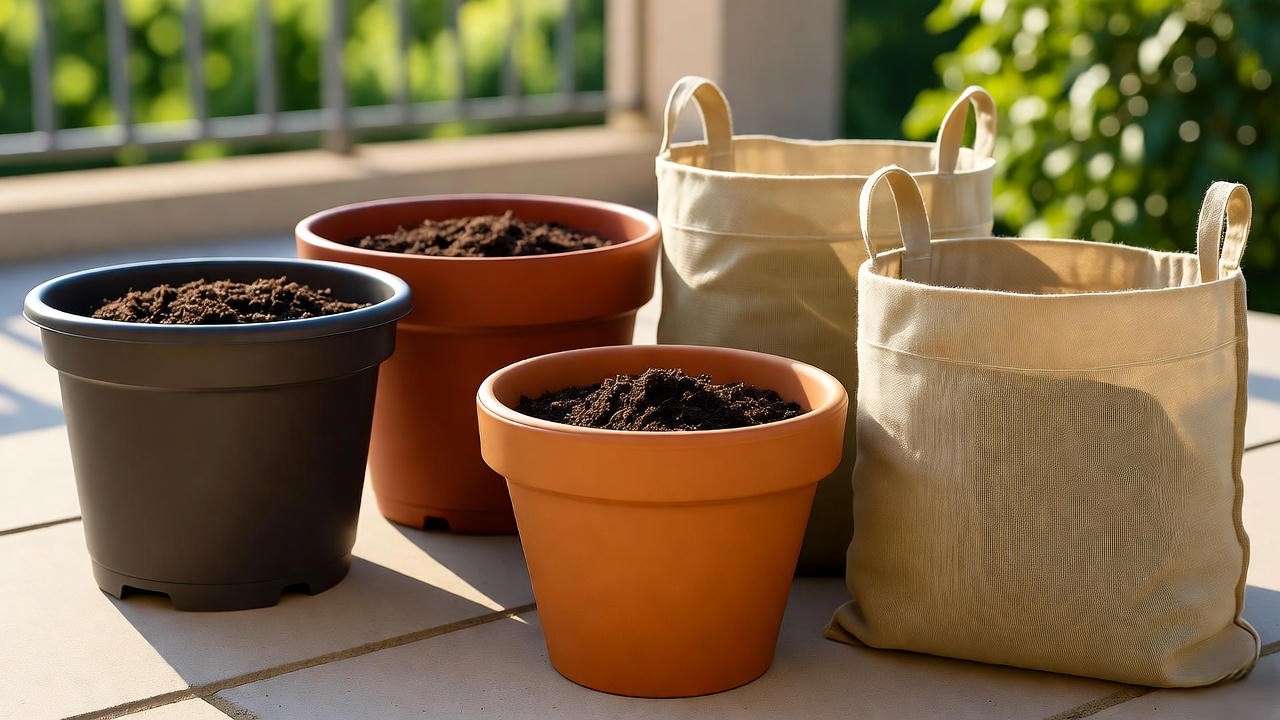
Soil Requirements for Patio Tomato Plants
Tomatoes thrive in well-draining, nutrient-rich soil with a pH of 6.0–6.8. Create a custom mix:
- 60% potting soil: Provides structure and water retention.
- 20% compost: Adds organic matter and nutrients.
- 20% perlite or vermiculite: Improves aeration and drainage.
Test soil pH with a home kit (available at garden centers) and adjust with lime (to raise pH) or sulfur (to lower it). Avoid heavy garden soil, which compacts in pots and suffocates roots.
Expert Insight: Mix in crushed eggshells or a calcium supplement to prevent blossom-end rot, a common issue in container tomatoes caused by calcium deficiency. 🥚
Case Study: A Seattle gardener boosted their patio tomato yield by 30% after switching to a custom soil mix with compost and perlite, ensuring better drainage and nutrient availability.
3. Mastering Watering and Fertilizing Techniques 💧
Proper watering and fertilizing are the backbone of thriving patio tomato plants. Containers dry out faster than garden beds, so consistency is crucial.
Watering Best Practices
Tomatoes need even moisture to avoid stress, which can lead to cracked fruit or stunted growth. Watering needs depend on pot size, weather, and growth stage:
- Seedlings: Water lightly every 1–2 days to keep soil moist but not soggy.
- Flowering/Fruiting: Water deeply when the top inch of soil feels dry, typically every 1–3 days in summer.
- Signs of Trouble: Overwatering causes yellowing leaves and root rot; underwatering leads to wilting or cracked fruits.
For convenience, consider drip irrigation or self-watering pots, which maintain consistent moisture levels. Always water at the base, not overhead, to keep foliage dry and reduce disease risk.
Pro Tip: Mulch the soil surface with straw or bark to retain moisture and regulate temperature. 🌾
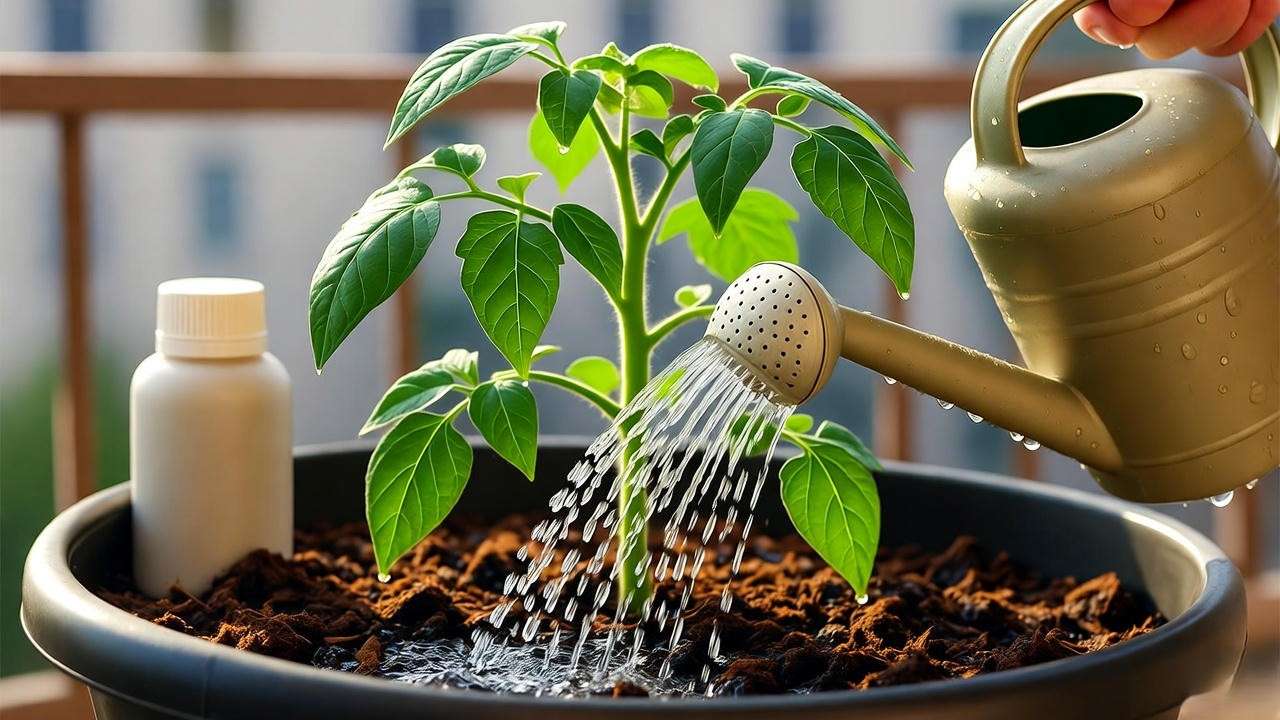
Fertilizing for Optimal Growth
Tomatoes are heavy feeders, especially in containers where nutrients deplete quickly. Use a balanced fertilizer like 10-10-10 or a tomato-specific blend (e.g., 5-10-10) with higher phosphorus for fruit production.
- Schedule: Fertilize weekly during flowering and fruiting, following package instructions.
- Organic Options: Fish emulsion or compost tea provides slow-release nutrients and boosts soil health.
- Avoid Overdoing It: Excess nitrogen promotes leafy growth at the expense of fruit.
Expert Advice: Dilute liquid fertilizers to half-strength for young plants to prevent burn. 🌿
Visual Aid Idea: Include a table showing nutrient needs at seedling, flowering, and fruiting stages to guide readers.
4. Providing Proper Support and Sunlight ☀️
Tomato plants, even compact varieties, need support and ample sunlight to produce a bountiful harvest in small spaces.
Supporting Your Patio Tomato Plants
Without support, tomato plants can topple or produce fewer fruits due to poor airflow. Options include:
- Staking: Use bamboo or metal stakes for single-stem plants. Secure with soft ties to avoid stem damage.
- Caging: Tomato cages are ideal for bushy determinate varieties, keeping branches upright.
- Trellising: Train indeterminate varieties on a trellis or string for vertical growth, saving space.
- DIY Idea: Create a cage from wire fencing or repurpose a hanging basket for dwarf varieties.
Pro Tip: Check supports weekly and adjust as plants grow to prevent breakage. 🪢
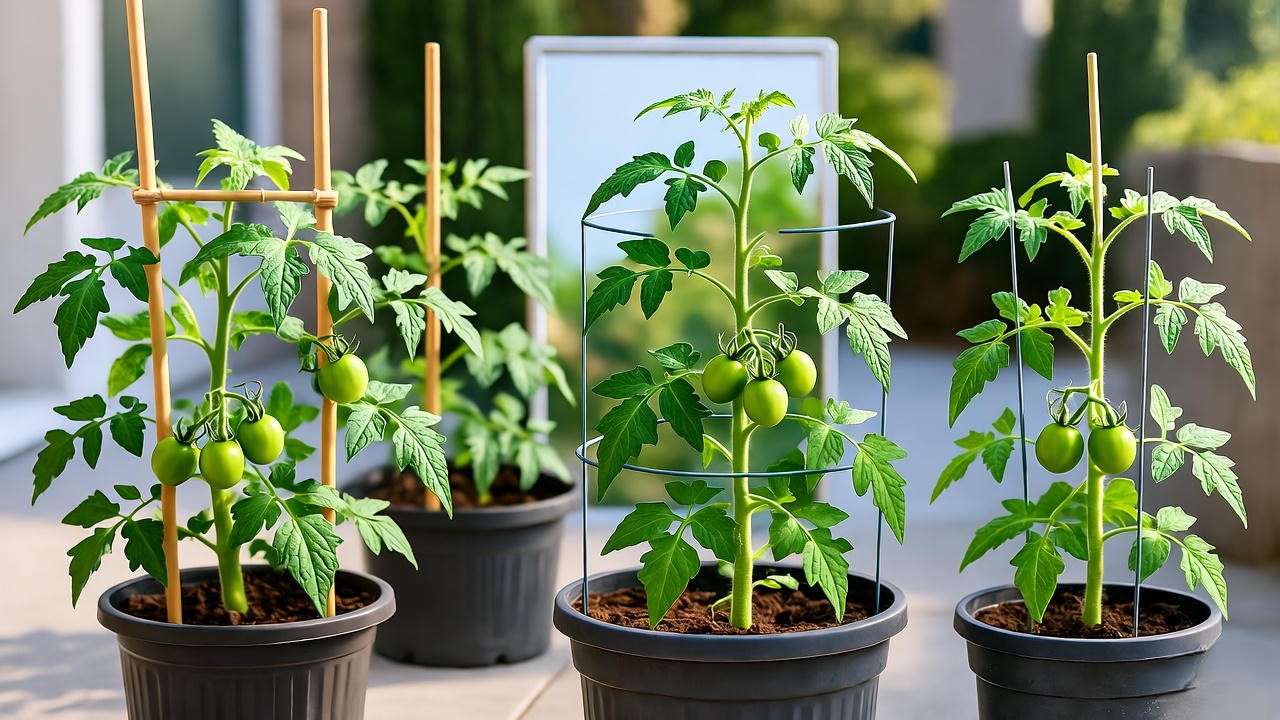
Sunlight Requirements
Tomatoes crave 6–8 hours of direct sunlight daily for optimal fruit production. In urban settings, patios may face shade challenges:
- Maximize Light: Place pots in the sunniest spot, often south-facing.
- Reflect Light: Use white or reflective surfaces (e.g., a mirror or aluminum foil) to bounce light onto plants.
- Rotate Pots: Turn containers weekly for even sun exposure, preventing lopsided growth.
Real-Life Example: A New York gardener doubled their tomato yield by placing a mirror behind their pots to reflect sunlight, proving creative solutions work in shaded spaces.
Expert Tip: If sunlight is limited, supplement with LED grow lights designed for fruiting plants. 💡
5. Pest and Disease Management for Patio Tomatoes 🐞
Patio tomato plants, like all tomatoes, are susceptible to pests and diseases, especially in confined spaces where airflow may be limited. Proactive management keeps your plants healthy and productive.
Common Pests
Urban patios can attract pests that harm tomato plants. Here’s how to identify and control them:
- Aphids: Tiny, sap-sucking insects clustering on new growth. Control with a strong water spray or insecticidal soap.
- Whiteflies: Small, white insects on leaf undersides. Use yellow sticky traps or neem oil.
- Spider Mites: Cause stippling on leaves; thrive in hot, dry conditions. Mist plants to increase humidity and apply neem oil.
Organic Solution: Plant marigolds or basil near your tomatoes as companion plants to repel pests naturally. 🌼
Preventing Diseases
Container tomatoes are prone to specific diseases, but proper care minimizes risks:
- Blossom-End Rot: Appears as dark, sunken spots on fruit bottoms due to calcium deficiency or uneven watering. Add calcium (e.g., eggshells) and maintain consistent moisture.
- Early Blight: Brown spots with concentric rings on leaves. Remove affected leaves and improve airflow by spacing pots.
- Powdery Mildew: White, powdery coating on leaves. Apply a baking soda spray (1 tsp per quart of water) and avoid overhead watering.
Expert Advice: Sterilize pots and tools with a 10% bleach solution annually to prevent fungal spread. 🧼
FAQ Section:
- Why are my tomato leaves yellowing? Likely overwatering, nutrient deficiency, or early blight. Check soil moisture and fertilize appropriately.
- How do I stop blossom-end rot? Ensure consistent watering and add calcium-rich amendments like crushed eggshells.
Bonus Tips for a Bountiful Harvest 🎉
To take your patio tomato plants to the next level, incorporate these expert strategies:
- Pruning for Productivity: Pinch off suckers (small shoots between the main stem and branches) to focus energy on fruit production. Remove lower leaves to improve airflow and reduce disease risk.
- Pollination Tricks: In windless patios or indoor settings, hand-pollinate by gently shaking flowers or using a small paintbrush to transfer pollen. This boosts fruit set, especially for cherry tomatoes.
- Harvest Timing: Pick tomatoes when they’re fully colored but still firm for peak flavor. For heirlooms, wait until they’re slightly soft for maximum sweetness.
- Companion Planting: Pair tomatoes with basil to enhance flavor or marigolds to deter pests. These plants also add beauty to your patio. 🌿
- Season Extension: Use cloches (plastic covers) or portable grow lights to extend the growing season, allowing harvests into fall or even year-round in mild climates.
Visual Aid Idea: Include a step-by-step photo guide for pruning suckers or hand-pollinating flowers to make these techniques accessible to beginners.
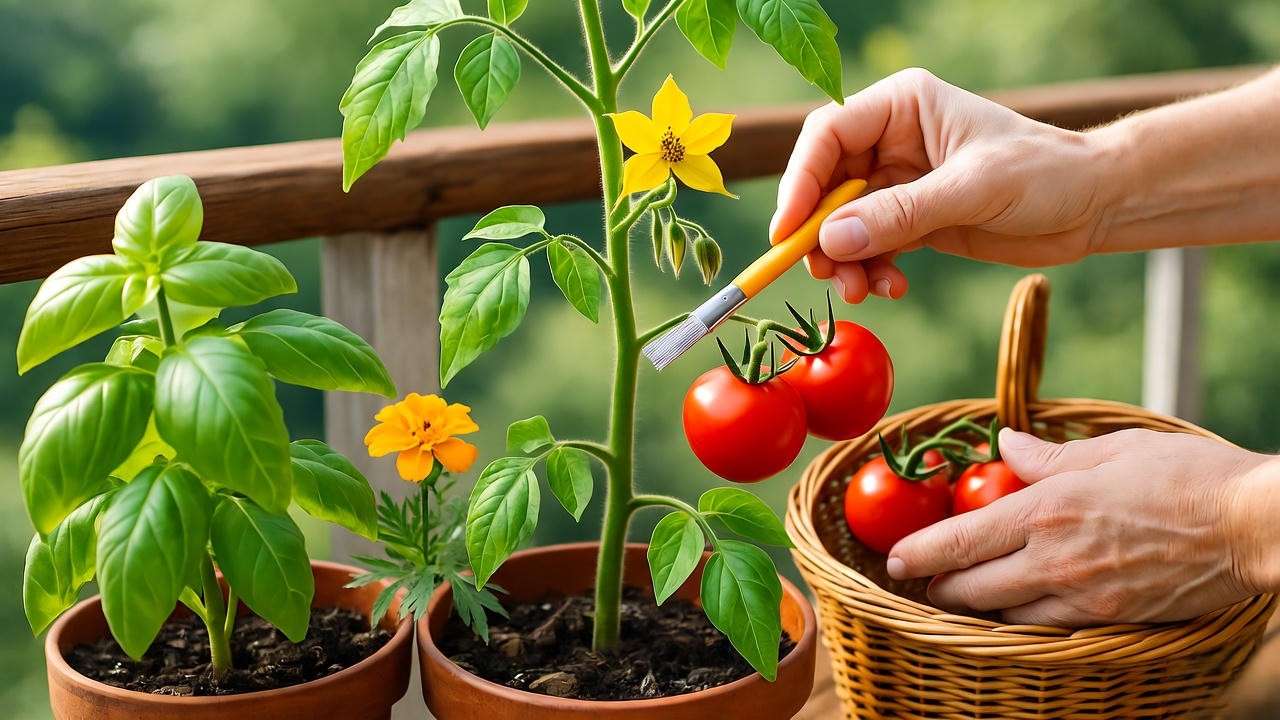
Conclusion: Your Path to Patio Tomato Success 🌞
Growing lush patio tomato plants is within reach for anyone with a small space and a passion for fresh produce. By choosing the right varieties, using proper containers and soil, mastering watering and fertilizing, providing support and sunlight, and managing pests and diseases, you’ll enjoy a bountiful harvest of juicy, homegrown tomatoes. Start with one pot, experiment with these expert tips, and watch your patio transform into a thriving garden. Share your tomato-growing journey in the comments below or try one of these tips this season—your taste buds will thank you! 🍅
FAQs for Patio Tomato Growers ❓
- How much space do patio tomato plants need?
Most varieties need a 5–15-gallon pot with 1–2 feet of space between plants for airflow. - Can I grow tomatoes on a shaded patio?
Yes, but aim for at least 6 hours of direct sunlight or supplement with grow lights. - What’s the best tomato variety for beginners?
Tiny Tim or Patio Princess are compact, forgiving, and produce quickly. - How do I know when my tomatoes are ready to harvest?
Harvest when fruits are fully colored, firm, and slightly soft to the touch. - Can I reuse soil from last season for my patio tomatoes?
Avoid reusing soil to prevent disease buildup. If necessary, sterilize with heat and replenish with fresh compost.

